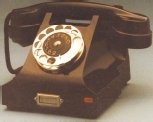The Modern Telephone - Communication in the Inter-War Period I
01. May. 2008

The so-called Sewing Machine, L.M. Ericsson, Stockholm, 1892
New Times, New Designs
In the 1920's and 1930's, modernity had its breakthrough in Copenhagen. New kinds of architecture, art, and design saw the light of day at the same time as telephones and radios began to influence people's everyday life. Eventually, as the telephone gained ground parallel with the development in the technical field, the look of the telephone changed. A dial had become necessary in the Copenhagen area at the end of the 1920's with the introduction of the so-called D-system where subscribers had to dial the exchange they wanted contact with themselves. At first, a large disk with letter combinations and ciphers was added to an old telephone model, but a new model soon followed in which the dial had been included from the start.
The demand for apparatuses with dials became nationwide concurrently with the full automation of telephony which took place during the decades following World War II, but the introduction of the dial belongs to the inter-war period and brought along new thinking and simplification of telephone designs.
Engineers' Constructions
The new models settled with the artful constructions of the late 19th century which actually had the purpose of dis-playing the technology. In the era of mechanics, the tech-nician controlled the industrial production whilst the designer was only let into the process at the very end. The culmination of the constructive era was the so-called skeleton appar-atuses; ingenious steel constructions built up around a core. In an attempt to civilize the raw, mechanical shapes the apparatuses were typically decorated with intertwining ornaments in Victorian style. The telephone was obviously a piece of handicraft rather than a mass produced item. And it was still reserved for the few.

L.M. Ericsson's bakelite telephone from 1932 became the archetype of international telephone design for decades.
Trail-Blazing Bakelite
During the first decade of the 20th century the appearance of telephone gradually became plainer. The new design fulfilled the demands of the time for simplicity, functionality, and mass production. The first telephones in which the technique was hidden and the construction toned down, assumed a charac-ter of architectonic idiom with edged and rectangular shapes.
Around 1930, telephones became more streamlined. At that time designers really made their appearance within the industry causing an increased focus on encapsulation of the technique and giving the telephone a more simple and handy form, an overall expression which needed no further decora-tion. At the same time a new material was introduced in the telephone industry: The bakelite. It was invented in 1907 by the Belgian chemist Leo Hendrik Baekeland and was one of the first types of synthetic plastic. It blazed the trail for designers' ideas and a whole new generation of sculpturally rather than architectonically shaped telephones.
It was not only within telephone design that functionalism broke though. Within architecture and design in general functionalism also made its mark resulting in great icons like the PH lamp and the Broadcasting House in Frederiksberg.
This article may be copied or quoted with MuseumsPosten, Post & Tele Museum as source.
Comment this article
Only serious and factual comments will be published.